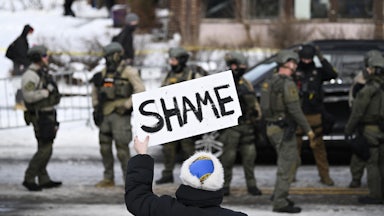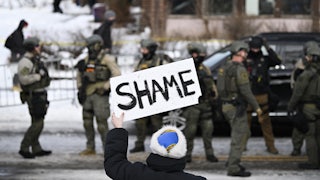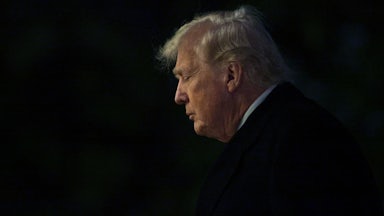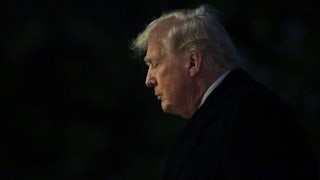The Supreme Court’s most high-profile cases this term dealt with the scope of Americans’ constitutional rights: whether New Yorkers’ right to obtain concealed-carry licenses had been infringed, whether a high school football coach had the right to lead team members in prayer after games, and even whether a constitutional right to abortion existed at all. The justices expanded rights in some areas and limited—or even extinguished them—in others.
But another group of cases that drew fewer headlines also dealt with Americans’ rights. In these cases, the Supreme Court addressed whether Americans could do anything when their rights were violated. Could they sue the officials involved? Could they seek remedies from the courts? The justices gave a fairly consistent answer to these questions: “No.”
There is no single ruling, of course, where the Supreme Court has declared something like, “Government officials should not be held accountable for their actions.” But the justices have come fairly close in the aggregate weight of their rulings, both this term and in previous ones. The result is the steady erosion of Americans’ ability to vindicate themselves in court—and sweeping impunity for those who violate them.
How do Americans respond when a civil servant—usually a cop, but not always—violates one of their constitutional rights? The most obvious step would be to file a lawsuit against them. If the infringer in question was a state or local official, a would-be litigant could theoretically use Section 1983. This Reconstruction-era provision broadly allows lawsuits in federal court against state and local officials who violate a person’s federal constitutional rights in their official capacity. In most cases, when you read about someone suing a cop or a public official on constitutional grounds in federal court, the plaintiff is using Section 1983.
In Vega v. Tekoh, Terence Tekoh tried to use Section 1983 to sue a Los Angeles police officer who had interrogated him without giving him a Miranda warning about allegations that he had inappropriately touched a patient while working as a nurse. While prosecutors then used his un-Mirandized statements against him at trial as evidence, the jury found Tekoh not guilty of sexual assault. Tekoh sued the officer and others for not Mirandizing him before the questioning, which Tekoh’s lawyers described as coercive.
The Ninth Circuit Court of Appeals ruled that Tekoh’s lawsuit could go forward because obtaining an un-Mirandized statement and using it against someone in a criminal trial violates the Fifth Amendment. But the Supreme Court disagreed. In a 6–3 ruling that fell along the usual ideological lines, the court decided that the Miranda rule was purely prophylactic and did not fall under Section 1983’s scope.
Writing for the court, Justice Samuel Alito explained that “while the benefits of permitting the assertion of Miranda claims under Section 1983 would be slight, the costs would be substantial” for the courts. He pointed to the need for “judicial economy,” which would be infringed if federal courts had to revisit facts found by state courts. He warned that allowing the lawsuit would create “unnecessary friction” between state courts and federal courts. And he listed potential “procedural issues,” briefly recapping the other legal questions that the court would also have to decide. While he emphasized what he saw as the limits of Miranda itself as a procedural rule, Alito also made clear that ruling in Tekoh’s favor would simply result in more work for the courts.
Justice Elena Kagan argued in dissent that Alito and the majority had completely misunderstood the court’s Miranda precedents. In her view, those past rulings had clearly described Miranda as a distinct constitutional rule, not one that merely excluded evidence at trial as a prophylactic measure to enforce the Fifth Amendment; that created an accompanying right. Kagan also emphasized the practical consequences for future litigants who have that right violated and, unlike Tekoh, are found guilty by a jury and serve time in prison.
That plaintiff “may succeed, on appeal or in habeas, in getting the conviction reversed,” she wrote, quoting from past rulings. “But then, what remedy does he have for all the harm he has suffered? The point of Section 1983 is to provide such redress—because a remedy ‘is a vital component of any scheme for vindicating cherished constitutional guarantees.’ The majority here, as elsewhere, injures the right by denying the remedy.”
The “elsewhere” to which Kagan referred was Egbert v. Boule, which the court had decided a few weeks earlier. That case also dealt with whether Americans could seek redress from the federal government when one of its employees violates their rights. As I noted last month, the case involved an unusual businessman who owns an inn on the U.S.-Canada border called the Smuggler’s Inn. For once, this was not false advertising: The proprietor had a long history of helping people illegally enter Canada for money, as well as a track record of working as an informant for federal law enforcement agencies that patrolled the border.
The lawsuit stems from an incident in which a Border Patrol agent had aggressively entered proprietor Robert Boule’s property without a warrant to question one of the inn’s guests, threw Boule to the ground and injured him, and then allegedly retaliated against him for filing an administrative grievance with the agent’s supervisor. Boule filed a lawsuit claiming that the agent had violated his Fourth Amendment rights during the initial episode and his First Amendment rights in the retaliation.
Section 1983 does not apply to federal officials, so Boule could not use it against the agent in this case. He instead filed what is known as a Bivens lawsuit, which is named for a 1971 Supreme Court decision. In that ruling, the court held that a man named Webster Bivens could sue six federal narcotics agents who violated his Fourth Amendment rights, even though Congress had not created a cause of action that would allow him to do it. The cause of action, the justices reasoned, was implicit from the constitutional text.
The Bivens ruling came just as the court’s ideological balance shifted away from the liberal justices and toward its centrist and later conservative wings. Since then, later generations of justices have resisted expanding Bivens to other constitutional rights and in some instances sought to curtail it. Justice Clarence Thomas, writing for the majority in Egbert, narrowed Bivens’s claims even further, almost to the point of oblivion. Lower courts could not allow a Bivens claim to go forward, Thomas concluded, if the federal government had provided an “alternative mechanism” for citizens to seek redress for an injury to their constitutional rights.
“So long as Congress or the Executive has created a remedial process that it finds sufficient to secure an adequate level of deterrence, the courts cannot second-guess that calibration by superimposing a Bivens remedy,” he wrote. In other words, because the Border Patrol had an administrative grievance process—one that recommended the agent’s dismissal in this case and then, for unknown reasons, did not follow through on it—Boule could not invoke Bivens to sue him for it. Thomas emphasized that this was acceptable even if the executive branch’s alternative process didn’t allow someone in Boule’s position to participate or appeal the outcome.
This time, Justice Sonia Sotomayor wrote the dissent, faulting the majority for inventing new standards and coming close to making things up to achieve a favorable outcome for the agent. “Existing precedent permits Boule to seek compensation for his injuries in federal court,” she wrote. “The Court goes to extraordinary lengths to avoid this result: It rewrites a legal standard it established just five years ago, stretches national-security concerns beyond recognition, and discerns an alternative remedial structure where none exists. The Court’s innovations, taken together, enable it to close the door to Boule’s claim and, presumably, to others that fall squarely within Bivens’ ambit.” Indeed, the circumstances in which the court will uphold future Bivens claims is far from clear.
It’s worth noting that the Supreme Court’s enthusiasm for impunity does not always fall along the typical ideological lines. Perhaps the best example this term came in United States v. Zubaydah, which dealt with the legal fallout from the CIA’s use of torture against detainees during the “war on terror.” The plaintiff, Abu Zubaydah, is still being held at the Guantánamo Bay facility today. He and his lawyers sought to subpoena two former CIA contractors who had participated in his torture on behalf of prosecutors in Poland, where the torture allegedly took place at a CIA “black site.”
The Justice Department sought to quash the subpoena under the state secrets doctrine, which generally allows the government to withhold evidence that could harm U.S. national security interests. But unlike, say, America’s nuclear weapons designs or the plans for the Normandy landings, Zubaydah’s treatment at the CIA’s hands is a well-established matter of public record. During litigation, the Ninth Circuit Court of Appeals concluded that the state secret privilege did not apply to publicly available information.
Yet in a fractured ruling, the Supreme Court ordered the lower courts to dismiss the case. “We agree with the Government that sometimes information that has entered the public domain may nonetheless fall within the scope of the state secrets privilege,” Justice Stephen Breyer wrote for the court. “The government here has provided a reasonable explanation of why Mitchell and Jessen’s confirmation or denial of the information Zubaydah seeks could significantly harm national security interests, even if that information has already been made public through unofficial sources.”
The ruling will make it harder for people to hold the government accountable for constitutional violations that it commits in the national security context, even in cases where the facts are already widely known. Justice Neil Gorsuch highlighted what he saw as the absurdity of the government’s claims. “The events in question took place two decades ago,” he wrote in a dissent joined by Justice Sonia Sotomayor. “They have long been declassified. Official reports have been published, books written, and movies made about them. Still, the government seeks to have this suit dismissed on the ground it implicates a state secret—and today the Court acquiesces in that request. Ending this suit may shield the government from some further modest measure of embarrassment. But respectfully, we should not pretend it will safeguard any secret.”
During oral arguments, the court accidentally stumbled across the consequences of giving such broad leeway to national security claims. Zubaydah’s case centered around obtaining the two contractors’ testimony about the torture he experienced in Poland. Why, Breyer asked Zubaydah’s lawyer, could Zubaydah himself not simply testify about his experiences? His lawyer replied that the government was still holding his client incommunicado. That seemed to astound Breyer, who noted that the war in Afghanistan had ended. “I mean, have you filed a habeas or something, get him out?” Breyer asked. “There has been a habeas proceeding pending in D.C. for the last 14 years,” the lawyer replied.
The court’s favoritism for impunity reaches its apex when it comes to qualified immunity cases. Qualified immunity is a judicially created doctrine that allows courts to dismiss Section 1983 cases if the plaintiff can’t prove the right violated by the public official was “clearly established” at the time. This framework frequently insulates officials from legal consequences for their actions. The doctrine has received persistent criticism from lower court judges and legal scholars across the ideological spectrum, as well as some of the justices themselves.
Compounding the problem is that the court rarely takes qualified immunity cases head-on. It often instead resolves them through summary reversals of the lower courts, without oral arguments or signed opinions by the majority. In some circumstances, it also simply lets inexplicable decisions by the lower courts stand without further review, over the dissents of some of the justices. Perhaps the best example from this term was in Ramirez v. Guadarrama. The court announced on the last day of the term this year that it would not take up the case.
The lawsuit was brought by Selina Marie Ramirez on behalf of herself, her two children, and the estate of her husband, Gabriel Eduardo Olivas. In 2017, the family called 911 while Olivas was experiencing a mental health crisis during which he doused himself in gasoline and threatened to light himself on fire inside their home. As his wife and children pleaded with him to stop, three officers arrived on the scene, one of whom had explicitly warned the other two not to use their Taser guns on Olivas because it risked igniting the gasoline.
The two officers ignored the warning and used their Tasers on Olivas, igniting the gasoline. The resulting fire killed Olivas and burned down the family’s home. The family sued the officers for violating the Fourth Amendment by using excessive force against Olivas. When the officers claimed qualified immunity, the district court declined to apply it at first. The Fifth Circuit Court of Appeals then reversed that decision and said the officers were entitled to immunity, finding that “given the horrendous scene that the officers were facing, involving the immediate potential for the destruction of lives and property, the force used—firing tasers—was not unreasonable or excessive.”
That ruling drew strong criticism from some members of the Fifth Circuit when the entire appellate court later reviewed the ruling and upheld it. The Supreme Court’s three liberal justices also criticized their fellow justices’ refusal to review the case. “According to those allegations, the officers elected to use force knowing that it would directly cause the very outcome they claim to have sought to avoid,” Sotomayor wrote. “That is, to prevent Olivas from lighting himself on fire and burning down the house, the officers tased Olivas just after they were warned that it would light him on fire.” This absurdity apparently did not persuade the other justices to intervene.
Favoring impunity for public officials is not a new phenomenon from the Supreme Court. Most of these cases built upon earlier cases that had previously narrowed Section 1983, Bivens, or other mechanisms for holding officials accountable. But it is worth highlighting after a term in which the nature of Americans’ constitutional rights became so widely debated. Americans correctly care a great deal when the Supreme Court defines, expands, or narrows a constitutional right. Another lesson from this term is that equal vigilance is warranted when it comes to ensuring that officials can be held to task for violating those rights when it happens.






